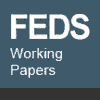
| Finance and Economics Discussion Series |
|---|
 |
GSEs, Mortgage Rates, and the Long-Run Effects of Mortgage Securitization Wayne Passmore, Roger Sparks, and Jamie Ingpen 2001-26 |
Abstract: Our paper compares mortgage securitization undertaken by
government-sponsored enterprises (GSEs) with that undertaken by
private markets, with an emphasis on how each type of mortgage
securitization affects mortgage rates. We build a model illustrating
that market structure, government sponsorship, and the characteristics
of the mortgages securitized are all important determinants of
mortgage rates. We find that GSEs generally--but not always--lower
mortgage rates, particularly when the GSEs behave competitively,
because the GSEs' implicit government backing allows them to sell
securities without the credit enhancements needed in the private
sector. Using our simulation model, we demonstrate that when mortgages
eligible for purchase by the GSEs have characteristics similar to
other mortgages, then implicit government backing generates
differences in mortgage rates that are similar to those currently
observed in the mortgage market (which range between zero and fifty
basis points). However, if the mortgages purchased by GSEs differ
substantially from other mortgages and the GSEs behave competitively,
the simulated spread in mortgage rates can be much larger than that
observed in the data.
Home | FEDS | List of 2001 FEDS papers
Accessibility
To comment on this site, please fill out our feedback form.
Last update: June 21, 2001